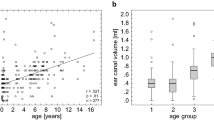Abstract
Using tympanometry we investigated potential changes in both middle ears developing during and after unilateral acute otitis media (AOM) in Japanese children. In 144 children with unilateral AOM, tympanometry was performed at presentation and was repeated at the 1st, 2nd, 3rd, and 4th weeks and then every 2 weeks up to 12 weeks after entry into the study. Type B tympanograms were recorded in 81 (56%) of the affected ears and in 37 (26%) of the unaffected ears at presentation. Twelve weeks after AOM, the type B tympanogram was still observed in 21 (15%) of the affected ears and in 16 (11%) of the unaffected ears. Ears with type B changes at presentation showed a significantly slower recovery of middle ear ventilation than did those with either type A or type C1.
Similar content being viewed by others
References
Asano K, Okamoto M, Fujieda I, Ogura S (1988) Screening test for day-care nursery children with otitis media with effusion (in Japanese). J Otolaryngol Jpn 91:41–48
Beery QC, Doyle WJ, Cantekin EI, Bluestone CD, Wiet RJ (1980) Eustachian tube function in an American Indian population. Ann Otol Rhinol Laryngol 89 [Suppl 68]:28–33
Brody JA, Overfield T, McAlister R (1965) Draining ears and deafness among Alaska Eskimos. Arch Otolaryngol 81:29–33
Doyle WJ (1977) A functiono-anatomic description of eustachian tube vector relations in four ethnic populations: an otologic study Dissertation, University of Pittsburgh, Pittsburgh
Fiellau-Nikolajsen M (1983) Tympanometry and secretory otitis media. Observations on diagnosis, epidemiology, treatment, and prevention in prospective cohort studies of three-year-old children. Acta Otolaryngol [Suppl] (Stockh) 394:1–73
Finitzo T, Friel-Patti S, Chinn K, Brown O (1992) Tympanometry and otoscopy prior to myringotomy: issues in diagnosis of otitis media. Int J Pediatr Otorhinolaryngol 24:101–110
Gates GA (1993) Acute otitis media and otitis media with effusion. In: Cummings CW (ed) Otolaryngology head and neck surgery, 2nd edn. Mosby, St. Louis, pp 2808–2822
Gregg JB, Steele JP, Clifford S, Werthman HG (1970) A multidisciplinary study of ear disease in South Dakota Indian children. South Dakota J Med 23:11–20
Griffith TE (9179) Epidemiology of otitis media. An interracial study. Laryngoscope 9:22–30
Groothuis JR, Sell SHW, Wright PF, Thompson RN, Altemeier WA (1979) Otitis media in infancy: tympanometric findings. Pediatrics 63:435–442
Halama AR, Voogt GR, Musgrave GM (1986) Prevalence of otitis media in children in a black rural community in Venda (South Africa). Int J Pediatr Otorhinolaryngol 11:73–77
Ishizu Y, Ikoma H, Hasegawa K (1990) Tympanograms of infants and children in Akoh City (in Japanese). Otologia (Fukuoka) 36:1069–1074
Jerger J (1970) Clinical experience with impedance audiometry. Arch Otolaryngol 92:311–324
Kaneko Y, Okitsu T, Sakuma M, Shibahara Y, Yuasa R, Takasaka T, Kawamoto K (1984) Incidence of secretory otitis media after acute inflammation of the middle ear cleft and the upper respiratory tract. In: Lim DJ, Bluestone CD, Klein JD, Nelson JD (eds) Recent advances in otitis media with effusion. Decker, Philadelphia, pp 34–36
Le CT, Freeman DW, Fireman BH (1991) Evaluation of ventilating tubes and myringotomy in the treatment of recurrent or persistent otitis media. Pediatr Infect Dis J 10:2–11
Leth N, Tos M (1977) Middle ear ventilation after acute otitis media. ORL 39:278–284
Marchant CD, Shurin PA, Turcyzk VA, Feinstein JC, Johnson CE, Wasikowski DE, Knapp LJ, Tutihasi MA (1984) A randomized controlled trial of cefaclor compared with trimethoprim-sulfamethoxazole for treatment of acute otitis media. J Pediatr 105:633–638
Miller SA, Omene JA, Bluestone CD, Torkelson DW (1983) A point prevalence of otitis media in a Nigerian village. Int J Pediatr Otorhinolaryngol 5:19–29
Mills RP (1987) Persistent ear effusions in children with recurrent acute otitis media. Clin Otolaryngol 12:97–101
Odio CM, Kusmiesz H, Shelton S, Nelson JD (1985) Comparative treatment trial of augmentin versus cefaclor for acute otitis media with effusion. Pediatrics 75:819–826
Okitsu T, Kaneko Y, Kawamoto K, Yuasa R (1979) Impedance audiometry for school screening (in Japanese). J Otolaryngol Jpn 82:785–792
Qvarnberg Y (1981) Acute otitis media. A prospective clinical study of myringotomy and antimicrobial treatment. Acta Otolaryngol [Suppl] (Stockh) 375:1–157
Sato A, Iio K (1985) Changes of the tympanogram after acute otitis media in children. Results of screening tests and questionnaires (in Japanese). Pract Otol (Kyoto) 78:31–40
Schwartz RH, Schwartz DM, Rodriguez WJ (1981) Otitis media with effusion (OME): natural course in untreated children. Pediatr Res 15:556
Schwartz RH, Rodriguez WJ, Grundfast KM (1984) Duration of middle ear effusion after acute otitis media. Pediatr Infect Dis 3:204–207
Shurin PA, Pelton SI, Donner A, Klein JO (1979) Persistence of middle ear effusion after acute otitis media in children. N Engl J Med 300:1121–1123
Stangerup SE, Tos M (1985) The etiologic role of acute suppurative otitis media in chronic secretory otitis. Am J Otol 6: 126–131
Takahashi S, Sato Y, Imai A, Ootaki H, Nakano Y (1985) Incidence and clinical features of otitis media with effusion in children aged three to five years (in Japanese). Pract Otol (Kyoto) 78:1917–1922
Teele DW, Klein JO, Rosner BA (1980) Epidemiology of otitis media in children. Ann Otol Rhinol Laryngol 9 [Suppl 68]: 5–6
Thomsen J, Meistrup-Larsen KI, Sorensen H, Larsen PK, Mygind N (1980) Penicillin and acute otitis: short and long-term results. Ann Otol Rhinol Laryngol 89 [Suppl 68]:271–274
Toner JG, Mains B (1990) Pneumatic otoscopy and tympanometry in the detection of middle ear effusion. Clin Otolaryngol 15:121–123
Wheeler MTK (1986) Tympanometry in children with treated acute otitis media. Lancet 1:529–532
Wiet RJ (1979) Patterns of ear disease in the Southwestern American Indian. Arch Otolaryngol 105:381–385
Wilmot JF, Cable HR (1988) Persistent effusion following acute otitis media: tympanometry and pneumatic otoscopy in diagnosis. J R Coll Gen Pract 38:149–152
Author information
Authors and Affiliations
Rights and permissions
About this article
Cite this article
Sakaguchi, M., Taguchi, K., Ishiyama, T. et al. Tympanometric changes following acute otitis media in Japanese children. Eur Arch Otorhinolaryngol 251, 113–116 (1994). https://doi.org/10.1007/BF00179904
Received:
Accepted:
Issue Date:
DOI: https://doi.org/10.1007/BF00179904




